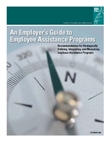
New Employer's Guide to EAPs Out Today
"An Employer's Guide to Employee Assistance Programs" is a new document being released today by the National Business Group on Health, an association of more than 300 large employers. The organization's president, Helen Darling, will announce it at the National Press Club today along with Kathryn Power, director of SAHMSA's Center for Mental Health Services, and Paul Heck, manager of global employee assistance & worklife services for DuPont Company.
NBGH says the guide was developed after a study of best practices and evidence-based approaches to the design and delivery of effective and efficient employee assistance programs. Funded by the Substance Abuse and Mental Health Services Administration and conducted by NBGH's Employee Assistance Workgroup, a 27-member committee of EAP, behavioral, and mental health services experts, the study took almost two years.
"For decades, EAPs have been providing value to employers, employees, and families with various services. In fact, one can see their value by the increase of utilization of services during this recession," Darling said. "Despite this recognition of the value of EAPs, there is a continued lack of definition, coordination, and the rigorous cost-impact assessment necessary for employers and their employees to understand and derive full benefit from EAPs."
NBGH created the EAP Workgroup to develop recommendations to improve the coordination and integration of employee assistance programs. The group believes aligning an EAP with an organization's values and vision generates a positive return on investment, improves business operations and employees' experience, and bolsters community perceptions of the company.
"Mental health and substance-use conditions continue to be among the leading causes of illness and lost productivity for most large employers," said Power. "EAPs represent a first-line response to providing prevention, triage, and short-term problem-resolution services within an organization. As such, they enable employers to leverage the value of their investment in their workforce, address the costs of doing business, and mitigate business risks."
For a copy of the guide and more information about EAPs, visit www.businessgrouphealth.org.